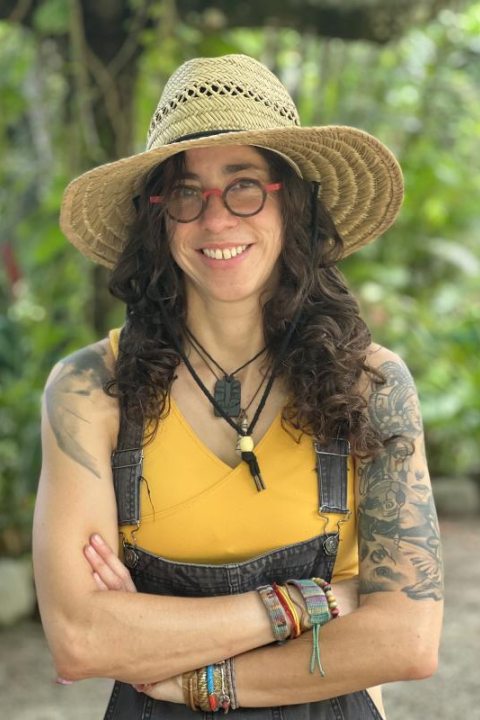
Associate Professor
Contact Information
230 Shineman Center
315.312.2469
[email protected]
Lab website
Office hours
Tuesdays and Thursdays from 10:30 to 11:30am.
Research
The importance of communication in promoting the evolution of sociality and strong social interactions.Foraging ecology of mammals adapted to seasonal changes.Community bats: Ecology of bats living in urban and rural environments
Specialty areas:
- Behavioral Ecology
- Bioacoustics
- Mammalogy
*Indicates undergraduate research student
Sagot, M; N. Rose; & G. Chaverri. 2024. Group vocal composition and decision making during roost finding in Spix’s disk-winged bats. Philosophical Transactions B. In press.
Chaverri, G. M. Sagot; J. Stynoski; M. Araya-Salas; Y. Araya-Ajoy; M. Nagy; M. Knörnschild; S. Chaves-Ramírez; N. Rose; M. Sánchez-Chavarría; Y. Jiménez-Torres; D. Ulloa-Sanabria; H. Solís-Hernández; & G. G. Carter. 2024. Calling to the collective: Contact calling rates within groups of disc-winged bats do not vary by kinship or association. Philosophical Transactions B. In press.
Chaves-Ramírez, S., Sagot, M., Sánchez-Chavarría, M., & Chaverri, G. 2023. Aggressive vocalizations during intergroup interactions in roost defense in the Spix’s disk-winged bat. Ethology, 00, 1–10. https
://doi.org/10.1111/eth.13391 Vivas-Toro, I., N. Martínez-Méndez, M. Sagot, G. León-Avila & J. Ortega. 2023. Landscape genetics of the Southern flying squirrel (Glaucomys volans) in the northeastern United States. Journal of Mammalogy, 104 (3): 519–531,https://doi.org/10.
1093/jmammal/gyad009 Sagot, M., G. Giacomini, S. Chaves Ramírez, H.A. Hernández Pinsón, & G. Chaverri. 2022. Vocal behavior and the use of social information during roost finding. Frontiers in Ecology and Evolution.
Chaverri, G.; Sandoval-Herrera, N.; Iturralde-Polit, P.; Romero, A.; Chaves-Ramírez, S. & Sagot, M. 2021. The energetics of social signaling during roost location in Spix’s disc-winged bats. Journal of Experimental Biology, 224.
Razik, I*. & Sagot. M. 2020. Vertebrate species richness at littoral beaver lodges in a temperate artificial pond. Journal of Fish and Wildlife Management. "11 (2): 422–429 11 (2): 422–429."
Chaverri, G.; Araya-Ajoy, J. & Sagot. M. 2020. Calling in context: intra- and intergroup variation in vocalization rates depend on a call’s function. Behavioral Ecology and Sociobiology, 74:57.
Nelson, M.L.* & Sagot, M. 2018. Effects of temperature and day length on daily movements and home range of the southern flying squirrel (Glaucomys volans) in the Northeastern United States. Northeastern Naturalist 25:383-390.
Sagot, M., C. Schöner, A. Jago*, I, Razik*, &, G Chaverri. 2018. The importance of group vocal behavior in roost finding. Animal Behavior.
Montero, B. K., Sagot, M., Phillips, C. D., Baker, R. J., & Gillam, E. H. 2018. Geographic variation of contact calls suggest distinct modes of vocal transmission in a leaf-roosting bat. Behavioral Ecology and Sociobiology, 72: 125.
Macchiano, A*, I Razik* & Sagot, M. 2018. Same sex courtship behaviors in male-biased populations: Evidence for the mistaken identity hypothesis. Acta Ethologica.
Sagot, M., C. D. Phillips, R. J. Baker & R. D. Stevens. 2016. Human-modified habitats change patterns of population genetic structure and group relatedness in Peter’s tent-roosting bats. Ecology and Evolution DOI: 10.1002/ece3.2255.
Sagot, M. 2016. Effects of range, habitat and roosting ecology in patterns of group association in bats. Pp 247-259. In: Ortega, J (ed), Sociality on Bats. Springer.
Sagot, M., & G. Chaverri. 2015. Effects of roost specialization on extinction risk in bats. Conservation Biology, in press.
Sagot, M., C. D. Phillips, R. D. Stevens, & R. J. Baker. 2013. Development and characterization of seventeen microsatellite loci for Peter's tent-roosting bat (Uroderma bilobatum). Conservation Genetics Resources.
Gillam, E., Chaverri, G., Montero, K., and Sagot, M. 2013. Social calls produced within and near the roost in two species of tent-making bats, Dermanura watsoni and Ectophylla alba. Plos One 0061731.
Sagot, M., B. Rodríguez-Herrera & R. Stevens. 2013. Macro and Microhabitat Associations of the Peter's Tent-Roosting Bat (Uroderma bilobatum): Human Induced Selection and Colonization? Biotropica 45: 511-519.
Sagot, M. 2012. Unravelling ecological effects on social behavior: insights from tent-roosting bats. Mastozoología Neotropical 19:193-194.
Sagot, M., & R. D. Stevens. 2011. The evolution of group stability and roost persistence: A case of study in tent-roosting bats. Biotropica 44: 90-97.
Sagot, M. 2004. The effects of the decline of bats. In: J. Szendeffy, D. Miller & L. Andrews (eds), CELOP. Boston University Editorial.Sagot, M. 2003. Herpetofauna de mantillo comparando un bosque y un cacaotal en cinco años. (Longterm diversity study of leaf litter herpetofauna in forests and cacao plantations) In: F. Bolaños & J. Lobo (eds). Biología de Campo. Universidad de Costa Rica. Book chapter.
Sagot, M. 2003. Área de corte y efecto en el flujo de agua por la lámina foliar en construcción de tiendas por parte de Artibeus watsoni (Chiroptera: Phyllostomidae) en Carludovica sp (Effects of tent-making by Dermanura watsoni in the water flow of Carludovica sp. leaves). In: F. Bolaños & J. Lobo (eds). Biología de campo. Universidad de Costa Rica. Book chapter.
Rodríguez-H, B., S. Rodríguez, & M. Sagot. 2001. Tent use in Pentagonia donnell-smithii (Rubiaceae) by Vampyressa pusilla (Chiroptera: Phyllostomidae) in Costa Rica. Bat Research News 42(2): 49.
Education
- Ph.D., Biological Sciences, Louisiana State University
- B.S., Biology, Universidad de Costa Rica